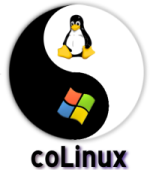
The Common Desktop Environment (CDE) is a desktop environment for Unix and OpenVMS, based on the Motif widget toolkit. It was part of the UNIX 98 Workstation Product Standard, and was for a long time the Unix desktop associated with commercial Unix workstations. It helped to influence early implementations of successor projects such as KDE and GNOME, which largely replaced CDE following the turn of the century.

Cooperative Linux, abbreviated as coLinux, is software which allows Microsoft Windows and the Linux kernel to run simultaneously in parallel on the same machine.
phpLDAPadmin is a web app for administering Lightweight Directory Access Protocol (LDAP) servers. It's written in the PHP programming language, and is licensed under the GNU General Public License. The application is available in 14 languages and supports UTF-8 encoded directory strings.
A hypervisor, also known as a virtual machine monitor (VMM) or virtualizer, is a type of computer software, firmware or hardware that creates and runs virtual machines. A computer on which a hypervisor runs one or more virtual machines is called a host machine, and each virtual machine is called a guest machine. The hypervisor presents the guest operating systems with a virtual operating platform and manages the execution of the guest operating systems. Unlike an emulator, the guest executes most instructions on the native hardware. Multiple instances of a variety of operating systems may share the virtualized hardware resources: for example, Linux, Windows, and macOS instances can all run on a single physical x86 machine. This contrasts with operating-system–level virtualization, where all instances must share a single kernel, though the guest operating systems can differ in user space, such as different Linux distributions with the same kernel.
Technical variations of Linux distributions include support for different hardware devices and systems or software package configurations. Organizational differences may be motivated by historical reasons. Other criteria include security, including how quickly security upgrades are available; ease of package management; and number of packages available.

The Quick Emulator (QEMU) is a free and open-source emulator that uses dynamic binary translation to emulate a computer's processor; that is, it translates the emulated binary codes to an equivalent binary format which is executed by the machine. It provides a variety of hardware and device models for the virtual machine, enabling it to run different guest operating systems. QEMU can be used with a Kernel-based Virtual Machine (KVM) to emulate hardware at near-native speeds. Additionally, it supports user-level processes, allowing applications compiled for one processor architecture to run on another.
In computing, virtualization is the use of a computer to simulate another computer. The following is a chronological list of virtualization technologies.
OpenJDK is a free and open-source implementation of the Java Platform, Standard Edition. It is the result of an effort Sun Microsystems began in 2006, four years before the company was acquired by Oracle Corporation. The implementation is licensed under the GNU General Public License 2 with a linking exception, preventing components that linked to the Java Class Library becoming subject to the terms of the GPL license. OpenJDK is the official reference implementation of Java SE since version 7, and is the most popular distribution of the JDK.

Kernel-based Virtual Machine (KVM) is a free and open-source virtualization module in the Linux kernel that allows the kernel to function as a hypervisor. It was merged into the mainline Linux kernel in version 2.6.20, which was released on February 5, 2007. KVM requires a processor with hardware virtualization extensions, such as Intel VT or AMD-V. KVM has also been ported to other operating systems such as FreeBSD and illumos in the form of loadable kernel modules.

oVirt is a free, open-source virtualization management platform. It was founded by Red Hat as a community project on which Red Hat Virtualization is based. It allows centralized management of virtual machines, compute, storage and networking resources, from an easy-to-use web-based front-end with platform independent access. KVM on x86-64, PowerPC64 and s390x architecture are the only hypervisors supported, but there is an ongoing effort to support ARM architecture in a future releases.

libvirt is an open-source API, daemon and management tool for managing platform virtualization. It can be used to manage KVM, Xen, VMware ESXi, QEMU and other virtualization technologies. These APIs are widely used in the orchestration layer of hypervisors in the development of a cloud-based solution.
libguestfs is a C library and a set of tools for accessing and modifying virtual disk images used in platform virtualization. The tools can be used for viewing and editing virtual machines (VMs) managed by libvirt and files inside VMs, scripting changes to VMs, creating VMs, and much else besides. It was created because of security issues, when virtual disk images are mounted directly on the host system.
In computing, SPICE is a remote-display system built for virtual environments which allows users to view a computing "desktop" environment – not only on its computer-server machine, but also from anywhere on the Internet – using a wide variety of machine architectures.
Second Level Address Translation (SLAT), also known as nested paging, is a hardware-assisted virtualization technology which makes it possible to avoid the overhead associated with software-managed shadow page tables.
Linux on IBM Z or Linux on zSystems is the collective term for the Linux operating system compiled to run on IBM mainframes, especially IBM Z / IBM zSystems and IBM LinuxONE servers. Similar terms which imply the same meaning are Linux/390, Linux/390x, etc. The three Linux distributions certified for usage on the IBM Z hardware platform are Red Hat Enterprise Linux, SUSE Linux Enterprise Server, and Ubuntu.

SmartOS is a free and open-source SVR4 hypervisor based on the UNIX operating system that combines OpenSolaris technology with bhyve and KVM virtualization. Its core kernel contributes to the illumos project. It features several technologies: Crossbow, DTrace, bhyve, KVM, ZFS, and Zones. Unlike other illumos distributions, SmartOS employs NetBSD pkgsrc package management. SmartOS is designed to be particularly suitable for building clouds and generating appliances. It was originally developed for and by Joyent, who announced in April 2022 that they had sold their business supporting and developing of Triton Datacenter and SmartOS to MNX Solutions. It is open-source and free for anyone to use.
bhyve is a type-2 (hosted) hypervisor initially written for FreeBSD. It can also be used on a number of illumos based distributions including SmartOS, OpenIndiana, and OmniOS. A port of bhyve to macOS called xhyve is also available.

Open vSwitch (OVS) is an open-source implementation of a distributed virtual multilayer switch. The main purpose of Open vSwitch is to provide a switching stack for hardware virtualization environments, while supporting multiple protocols and standards used in computer networks.

Borg is deduplicating backup software for various Unix-like operating systems. Borg is notably included in the Debian, Fedora, and Arch repositories.
git-annex is a distributed file synchronization system written in Haskell. It aims to solve the problem of sharing and synchronizing collections of large files independent from a commercial service or even a central server.











